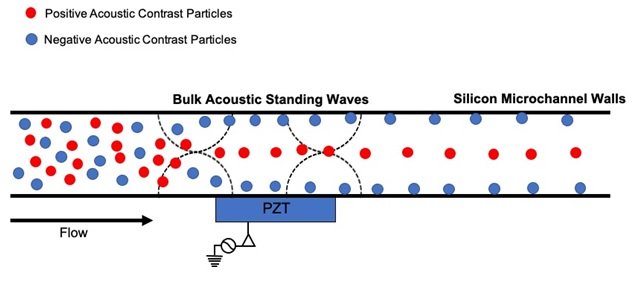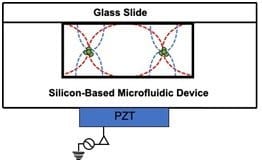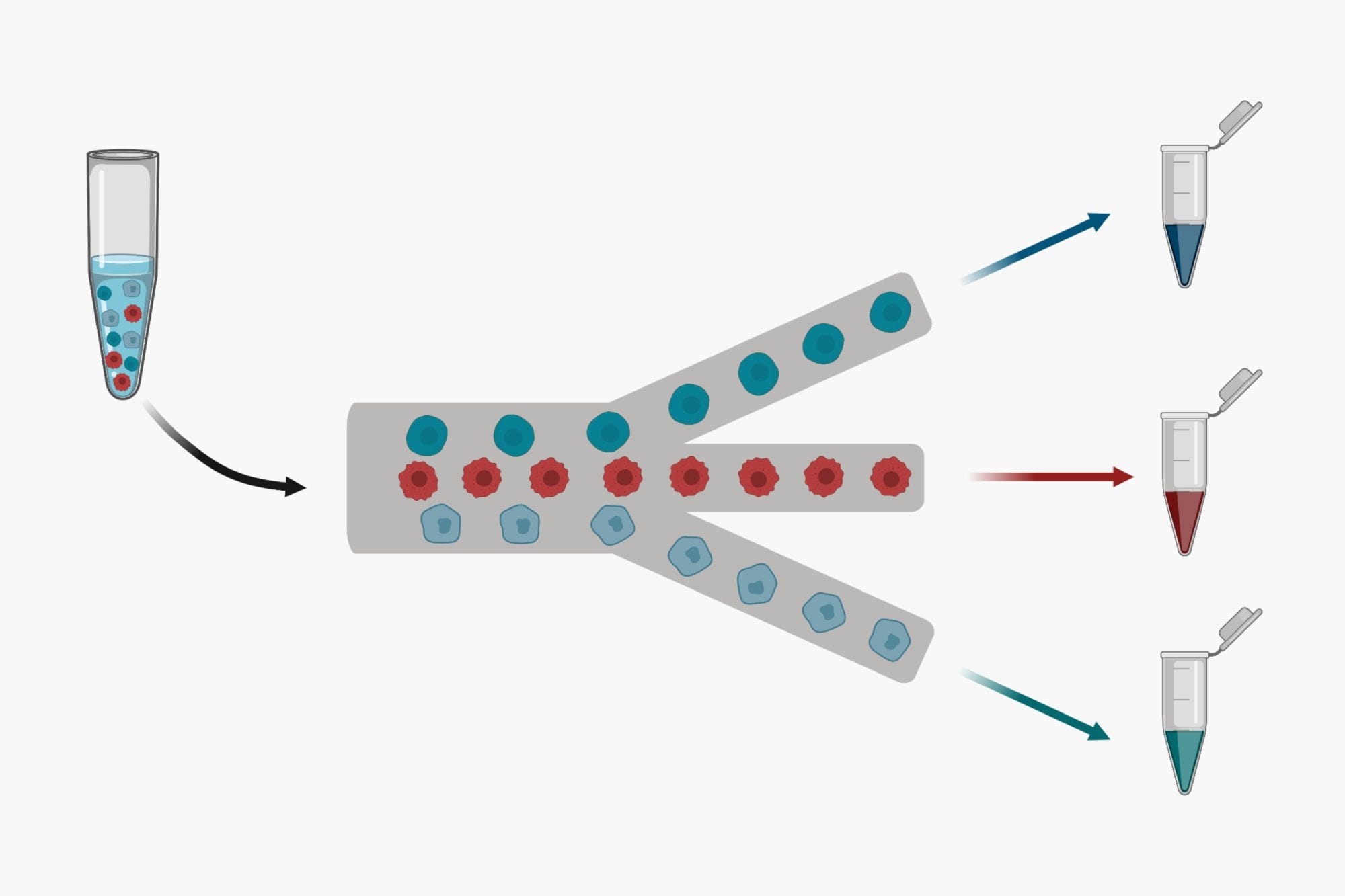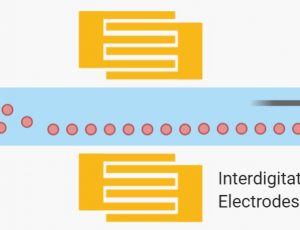Cell Sorting Using Sound Waves and Microfluidics
What is Microfluidic Acoustophoresis Used For?
The movement of particles or cells by the application of acoustic pressure is commonly referred to as acoustophoresis [1]. Microfluidics acoustophoretic separations of particles (or cells) in complex, heterogeneous liquid mixtures (e.g., blood) is an efficient method for sorting particle populations into purified fractions. Sorting of cells from complex mixtures has important implications for biotechnology, biology, and medicine. The integration of sound-based sorting methods into microfluidic chips has advantages such as automation, rapid time-to-results, high precision, accuracy, sensitivity. These are often the requirements for the development of point-of-care (POC) and diagnostic technologies. In general, particle sorting using sound waves in microfluidic devices can be used for concentrating [2], purifying [1], enriching [3], washing [4], and confinement-trapping [5].
How Does Acoustic Sorting Compare to Conventional Sorting Methods?
A significant advantage of using acoustic microfluidics sorting is that it is a non-contact method thus does not damage cells. Therefore the sorted and happy cells may be used for medically-relevant bioassays [6]. For example, for enrichment of medically-relevant cell types (e.g., cancer cells) for use as diagnostic or prognostic biomarkers[3]. These cell-biomarkers can assist medical clinicians in treating patients or help with the development of personalized medicine. Moreover, sorting with sound waves in microfluidic channels allows for precise alignment and positioning of particles or cells in laminar flow streams. This approach has been used for the development of on-chip flow cytometry devices [7].
On the other hand, the common method for sorting biological cells uses gradient centrifugation[8]. The centrifuges can handle large volume of liquid samples, but they are bulky compared to microfluidic based acoustic sorters. The inertia load and shear forces in centrifuges can damage cells. Other popular cell sorting methods are Fluorescence Activated Cell Sorting (FACS), and Magnetic Activated Cell Sorting (MACS). The methods require labeling the cells with marker reagents prior to sorting [9]. The labeling strategy enables efficient sorting but could render the cells useless for some applications such as organ on a chip or regenerative medicine. In practical terms, these conventional technologies do not align with what is needed in the research community, such as low energy consumption, short processing times, low cost, small liquid volumes, and portability. As a result, there is high demand for Microfluidics based sound sorting methods.
How Are Acoustic Waves Used in Microfluidics for Sorting Cells?
The acoustic waves are usually generated in three ways inside a microchannel filled with liquid. These are: Bulk acoustic standing waves (BASW)[10], Surface Acoustic Standing Waves (SASWs)[11], and Acoustic Travelling Waves [12]. BASW based microfluidic sorters have potential to generate faster acoustophoretic movement of particles than SASWs [13]. However, SASWs devices have greater precision for manipulating and positioning cells in the microfluidic channels [11]. Nevertheless, most work in particle sorting with microfluidics acoustophoresishas employs the BASW methods.
What is Primary Acoustic Force?
Formation of the acoustic standing wave (either BASW or SASW) in a microfluidic channel, results in Primary Acoustic Force (Fp) being exerted on suspended particles. To do so, there must be a difference in physical properties (density and compressibility) between the particles and their surrounding medium (e.g., fluid). The magnitude of Fp on particles is mainly proportional to the acoustic pressure amplitude within the liquid-filled microfluidic channel, the size (volume) of the particles, and their acoustic contrast factor (Φ)[6]. The value of Φ is calculated based on the density of the particles and their surrounding medium and the compressibility of the particles and their surrounding medium [6]. Depending on the value of Φ, particles that experience a primary acoustic force are either forced to pressure nodes or antinodes[6]. Particles that have a positive value of Φ are forced to pressure nodes and are referred to as positive acoustic contrast particles (PACPs); and particles with a negative value of Φ are forced to pressure antinodes and are referred to as negative acoustic contrast particles (NACPs)[6] (See Figure). Previous published works have shown that compressible elastomeric particles (PDMS-based) and lipids can function as NACPs [14, 15]; whereas most blood cells function as PACPs under an acoustic standing wave.
The magnitude of Fp on particles is mainly proportional to the acoustic pressure amplitude within the liquid-filled microfluidic channel, the size (volume) of the particles, and their acoustic contrast factor (Φ)[6]. The value of Φ is calculated based on the density of the particles and their surrounding medium and the compressibility of the particles and their surrounding medium [6]. Depending on the value of Φ, particles that experience a primary acoustic force are either forced to pressure nodes or antinodes[6]. Particles that have a positive value of Φ are forced to pressure nodes and are referred to as positive acoustic contrast particles (PACPs); and particles with a negative value of Φ are forced to pressure antinodes and are referred to as negative acoustic contrast particles (NACPs)[6] (See Figure). Previous published works have shown that compressible elastomeric particles (PDMS-based) and lipids can function as NACPs [14, 15]; whereas most blood cells function as PACPs under an acoustic standing wave.
BASW Generation
BASWs are generated in fluid filled microfluidic channels by applying a voltage on a bulk piezoelectric transducer (PZT) that is coupled to the outside of the microfluidic device. A PZT converts the applied voltage (at geometrically defined resonance frequencies) into mechanical vibration. The vibration propagates throughout the bulk material of the microfluidic device (e.g., silicon) and transferred into the fluid-filled microfluidic channel to form the acoustic wave [16]. If the channel walls are fabricated to have a high acoustic impedance then a BASW will form inside the microfluidic channel [17].
SASW Generation
SASWs are generated in a similar fashion to BASWs using an interdigital transducer (IDT) coupled to the outside bottom of a microfluidic channel. The application of a voltage onto the IDT is used to generate SASWs that propagate along the surface of the microfluidic channel; the SASWs generate pressure nodes and antinodes in the liquid-filled cavity for particle separations [1].
Many of the medically-relevant applications of sound sorting with microfluidics involves concentrating biological entities with continuous flow. Concentrating biological entities (e.g., cells) with continuous microfluidics flow can improve detection sensitivity and reduce analysis time. Nordin et al., were able to show that their microfluidic chip design, which included 2-D BASW focusing and consecutive regions for concentration, could achieve a 200-fold increase in concentration for RBCs and prostate cancer cells [18]. They acoustically focused cells in a continuous flow to the center pressure node, while excess liquid was removed through the side outlet channels. Further, Jakobsson et al., engineered a microfluidic setup that merged BASW technology with a recirculating apparatus to achieve 1000-fold increase in concentration of RBCs and cancer cell lines (breast and prostate cancer)[2].
Label-Free Acoustic Cell Sorting
Label-free sorting of cells with sound in microfluidic channels relies on the properties of cells (e.g., size and F), only. The ability to sort cells without labeling is advantageous compared to traditional methods (e.g., FACS, MACS) because there is no need to cell-surface markers (e.g., epitopes). These markers are absent or down regulated in specific cell types (e.g., epithelial derived cancer cells)[19]. The absence or down regulation of specific epitopes on cell types, can lead to the clinically-targeted cells being missed in separation assays that require labeling (e.g., antibodies, peptides) [20]. The acoustic cell sorting can fill the void here. An example of label-free sorting with BASWs is the enrichment of cancer cells from RBC-lysed blood containing WBCs.  To achieve efficient separation of cancer cells from WBCs, Augustsson et al., implemented a pre-alignment channel that was used to focus a mixture of cells at pressure nodes in two dimensions: width (x) and height (z) (figure ).
To achieve efficient separation of cancer cells from WBCs, Augustsson et al., implemented a pre-alignment channel that was used to focus a mixture of cells at pressure nodes in two dimensions: width (x) and height (z) (figure ).
This pre-alignment step allowed the trajectories of all cells in the stream to start from the same position (x-z) when flowing into the separation channel (figure). The method ensures that cell populations would be separated solely on differences in acoustic properties (size and Φ) within the separation channel(figure)[20]. Using this microchannel configuration, several publications have shown cancer cell lines (breast and prostate) being efficiently separated from WBCs from RBC-lysed blood using acoustophoresis with BASWs [3, 20].This label-free separation occurs because larger-sized cancer cells focus faster to the center pressure node than WBCs in the separation channel; thus, if flow rates are optimized the WBCs will flow through the side outlet channel and cancer cells will be enriched in the collected middle fraction (figure ).

This figure has been modified from its original source:https://www.nature.com/articles/s41598-019-45182-3
Travelling Acoustic Wave Method
Though, the majority of acoustic-based sorting of cells and particles with microfluidics occurs with BASWs systems, there are microfluidic designs that use traveling acoustic waves (non-standing acoustic waves) for sorting cells. The use of traveling acoustic waves offers precise microscale manipulation of cells at high throughput sorting rates. Recently, such microfluidic acoustic travelling wave technologies have been engineered to operate as micro fluorescence activated cell sorting (μFACS) systems. It should be reminded that, these μFACS systems require the desired cell population (or particle) be fluorescently labeled. Ma et al., has also demonstrated a μFACS microfluidic device with acoustic travelling waves for cell sorting; it was able to sort fluorescently labeled breast cancer cells at ~kHz sorting rates in diluted whole blood [21]. A similar μFACS sorting microfluidic chip using travelling acoustic waves was developed by Weitz et al.; where their sorting system was able to obtain state of the art sorting rates and purities [12].
References and Further Reading
- Microfluidic cell sorting: a review of the advances in the separation of cells from debulking to rare cell isolation
- Thousand-fold volumetric concentration of live cells with a recirculating acoustofluidic device
- Clinical-Scale Cell-Surface-Marker Independent Acoustic Microfluidic Enrichment of Tumor Cells from Blood
- Acoustic radiation forces at liquid interfaces impact the performace of acoustophoresis
- Integrated Acoustic Separation, Enrichment, and Microchip Polymerase Chain Reaction Detection of Bacteria from Blood for Rapid Sepsis Diagnostics
- Applications of Acoustofluidics in Bioanalytical Chemistry
- Multinode acoustic focusing for parallel flow cytometry
- Microfluidic Adaptation of Density-Gradient Centrifugation for Isolation of Particles and Cells
- Acoustophoresis enables the label-free separation of functionally different subsets of cultured bone marrow stromal cells
- Acoustofluidic Blood Component Sample Preparation and Processing in Medical Applications, in Applications of Microfluidics Systems in Biology and Medicine
- Surface acoustic wave (SAW) acoustophoresis: now and beyond
- Sorting drops and cells with acoustics: acoustic microfluidic fluorescence-activated cell sorter
- Fabrication and Operation of Acoustofluidic Devices Supporting Bulk Acoustic Standing Waves for Sheathless Focusing of Particles
- Separation of lipids from blood utilizing ultrasonic standing waves in microfluidic channels
- Reducing WBC background in cancer cell separation products by negative acoustic contrast particle immuno-acoustophoresis
- Microscale acoustofluidics driven via acoustics and ultrasonics
- Acoustofluidics 5: Building microfluidic acoustic resonators
- Two-hundred fold volume concentration of dilute cell and particle suspensions using chip integrated multistage acoustophoresis
- Reducing WBC background in cancer cell separation products by negative acoustic contrast particle immuno-acoustophoresis
- Microfluidic, label-free enrichment of prostate cancer cells in blood based on acoustophoresis
- Fluorescence activated cell sorting via a focused traveling surface acoustic beam
Learn how microfluidics technology is used to sort and separate cells.
Use electric, magnetic or accoustic forces to sort and separate cells on microfluidic devices.




